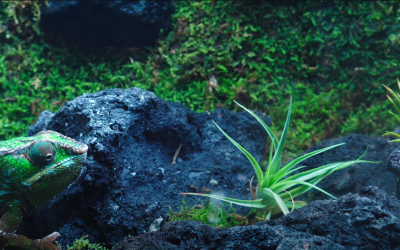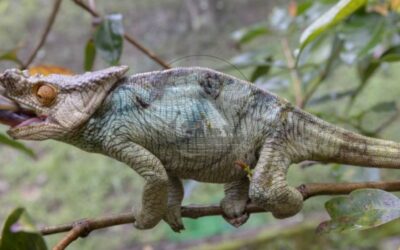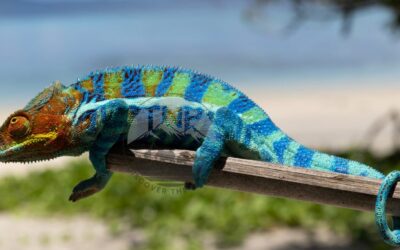The Malagasy wildlife is a treasure trove of animal wonders, and the Phelsuma grandis, or Madagascar day gecko, stands out among them. I have always been looking for geckos each of the five times I have been to Madagascar. Day Geckos seem more interesting than the others, likely due to their active behavior and dietary needs, which include calcium and vitamin supplements. This highlights the importance of a well-considered gecko diet.
I’ll highlight their unique characteristics, learn how to photograph them ethically, and discover the conservation efforts working to safeguard their habitats, focusing on species of day geckos and their needs.
Ten Types of Madagascar Day Geckos
Gold Dust Day Gecko (Phelsuma Llaticauda): This gecko, recognized by its bright green coloration with gold speckles, is commonly found in Madagascar’s forests and urban areas.
Check out Exploring the Rich Diversity of Madagascar Animals.

Giant Day Gecko (Phelsuma grandis): As one of the most significant day geckos, it boasts striking red and green hues and is frequently observed in natural habitats and captivity. It sometimes sips on a gecko drink made of sweet fruits.
Madagascar Velvet Gecko (Phelsuma Madagascariensis): This species inhabits various regions of Madagascar and has a velvety green appearance with hints of blue and red.
Peacock Day Gecko (Phelsuma Quadriocellata): Known for its vivid blue markings and red eyes, this gecko is found in the eastern rainforests of Madagascar, a familiar name among enthusiasts being celebrated for its striking appearance.
Standing’s Day Gecko (Phelsuma Standingi): With its distinctive yellowish-green body and orange-red markings, this species is native to the northern regions of Madagascar and is known to produce a waxy substance that helps them climb smooth surfaces.
Blue-Tailed Day Gecko (Phelsuma Cepediana): This gecko features a vibrant turquoise tail and green body. It is commonly seen in Madagascar’s coastal areas and islands, and it is distinct for its ability to thrive in various habitats, including the eastern coast of Madagascar.
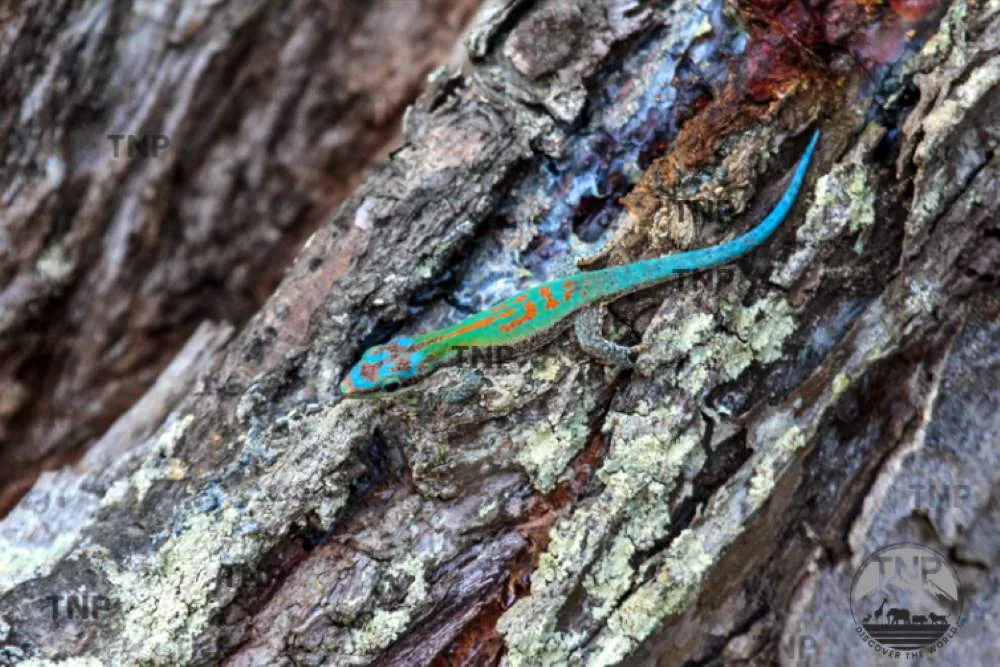
Turquoise Day Gecko (Phelsuma klemmeri): Endemic to the Andapa region, this gecko showcases stunning turquoise coloration with red markings.
Yellow-Headed Day Gecko (Phelsuma Kochi): Characterized by its bright yellow head and green body, this gecko inhabits the eastern rainforests of Madagascar.
Madagascar Flat-Tailed Day Gecko (Phelsuma Serraticauda): Named for its flattened tail, this gecko exhibits green coloration with red markings and is found in various habitats across Madagascar, including the lush forests of Maui.
Günther’s Day Gecko (Phelsuma Guentheri): This species combines green, yellow, and blue hues with distinctive red dots. It primarily inhabits Madagascar’s eastern rainforests.
The Fascinating Madagascar Day Gecko
I was fascinated when I first saw a Madagascar Day Gecko, known scientifically as Phelsuma grandis. Its vibrant greens and startlingly vivid red spots make it a delight to observe and a dream subject for any photographer, especially those of us drawn to the natural world’s splashier displays.
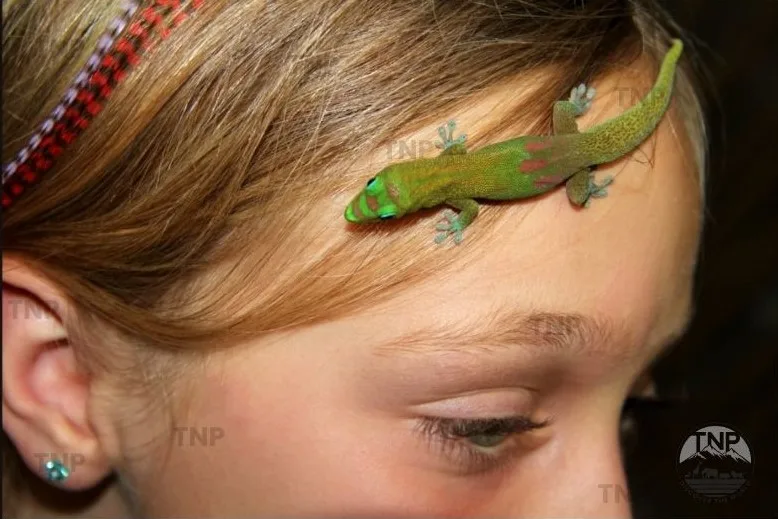
Description and Physical Characteristics of Geckos
Imagine a lizard that looks like nature’s vibrant palette has painted it. This characteristic makes them sought-after as exotic pets and highlights the need for a diet that includes calcium and vitamin supplements. The Madagascar Day Gecko is a striking creature adorned with emerald green skin that seems to glow under sunlight. Scattered across this radiant backdrop are dashes of red, usually around the neck and the back, adding to their exotic appeal and making them highly desirable as exotic pets.
How Large are Geckos?
These geckos are not particularly large; they typically grow to about 8 to 10 inches in size when fully mature, making them manageable as exotic pets. Seeing them cling to the side of a tree with their brightly colored bodies and soft, padded feet, adept at navigating smooth surfaces, is nothing short of mesmerizing.
Ideal Habitat for Madagascar Giant Day Gecko
The Madagascar Day Gecko is a true native of Madagascar, thriving in the lush rainforests and occasionally venturing into more human-dominated areas, where they might be seen sipping on a gecko drink derived from sweet fruits. However, their charm and adaptability have allowed them to find new homes far beyond Madagascar’s shores, even reaching the Hawaiian islands. For instance, in Hawaii and the Florida Keys, these geckos, known for their ability to cling to smooth surfaces easily, have become almost a local fixture, becoming an integral part of the ecosystems there.
Day Gecko Behavior and Lifestyle
As someone who’s spent countless hours observing the Madagascar Day Gecko, I’ve come to appreciate their stunning appearance, fascinating behaviors, and daily routines, cementing that geckos need specific habitat conditions to thrive. Let me share with you what makes these geckos so intriguing.
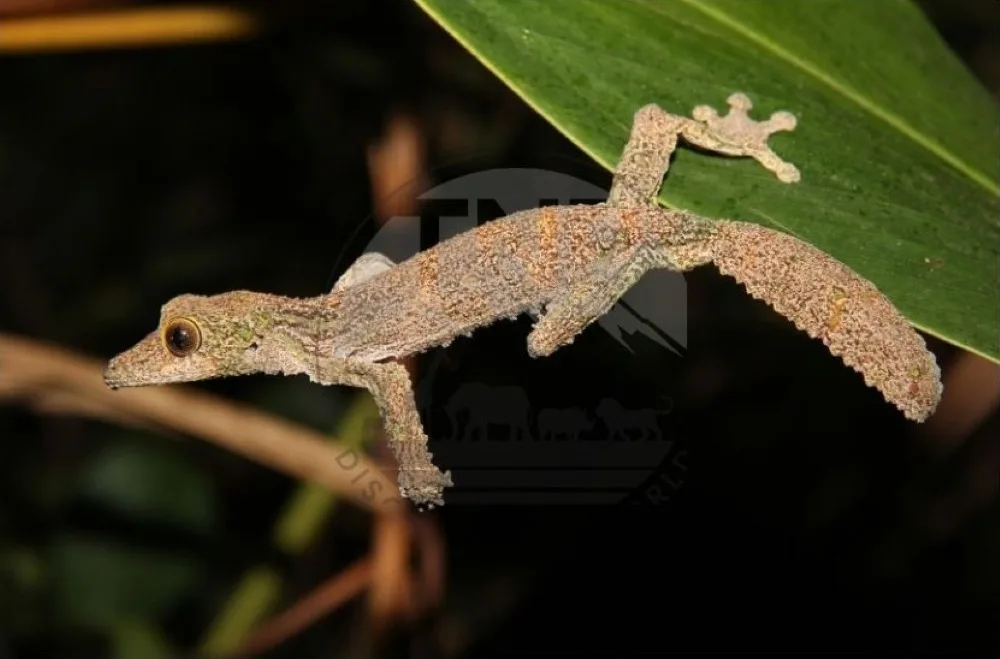
Daily Activities
As the sun rises, these diurnal geckos seek the sun every morning. This activity is vital as geckos are the only lizards that actively bask in full sunlight. They’re called “day geckos,” meaning they’re most active during the daytime.
Watching them wake up to the world is a treat—they’ll find a sunny basking spot, absorbing warmth to kickstart their day. It’s like witnessing a miniature sunbathing session but with a touch of reptilian grace, especially when you watch crested geckos, with their unique ability to produce a waxy substance that aids their grip.
Once they’re fully energized, they begin exploring their habitat. Their vocalizations range from squeaks and clicks to barks and croaks, adding to the complexity of their behavior and indicating the importance of vitamin D3 in their diet. With their agile bodies and specialized feet that can grip almost any surface, they move remarkably quickly through the branches and leaves, a testament to their big personality and adaptability.
Geckos Can Be Social Among Their Kind
Sometimes, you’ll catch them indulging in socializing as they interact with fellow geckos, perhaps exchanging pleasantries or staking out their territory.
It’s fascinating to watch them stalk their prey precisely, using their keen eyesight to track down even the smallest insects. Once they’ve secured their meal, they’ll settle for a satisfying feast, showcasing their resourcefulness in the wild.
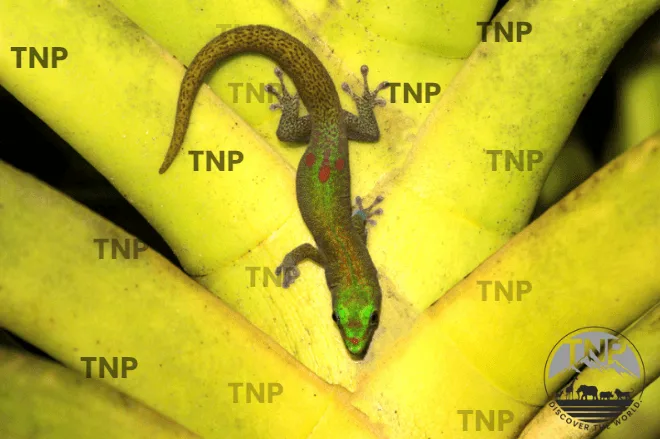
Diet and Feeding Habits
The diet of the Day Geckos is diverse, consisting of items that make them suitable for various environments, even as exotic pets. This includes the necessity for calcium and vitamin supplementation. Geckos eat everything from juicy fruits to crunchy insects, illustrating the wide range of diets gecko species enjoy. This is vital to the gecko diet, a testament to their adaptability and opportunistic nature.
I’ve observed them feasting on ripe fruits, using their delicate tongues to lap the sweet nectar. When it comes to insects, they’re skilled hunters. They lurk around trees with their unique toe pads darting after their prey with lightning speed. They also eat crickets once or twice a week, a dietary habit that can be easily managed by those keeping them as exotic pets.
How Often Does A Chameleon Eat: A Comprehensive Guide
Reproduction Process For Day Geckos
Breeding Season and Courtship Displays
During the warmer months, male Madagascar Day Geckos engage in elaborate displays to attract females. They utilize their ability to produce a waxy substance that allows them to cling to smooth surfaces easily. These displays can range from vocalizations to colorful body movements, all aimed at proving their worthiness as mates. This behavior is unique since geckos are the only lizards producing such vocal sounds.
Mating and Egg-laying Behavior
Once a pair has formed, mating occurs, often in secluded areas away from predators, indicative of their territorial behavior. Female geckos then lay their eggs in hidden crevices or under leaves, providing them with a safe environment to develop for 47 to 82 days. This highlights the importance of a secure habitat for the species of day geckos.
They have a way of communicating with their fellow geckos by hissing, barking, and croaking.

Conservation Status of Madagascar Day Gecko
Threats to Survival
Habitat loss due to deforestation and the illegal pet trade pose significant challenges to the survival of the Madagascar Day Gecko, especially for those found on the eastern coast of Madagascar. These threats have led to their near-threatened status on the IUCN Red List, highlighting the need to conserve these diurnal creatures.
Conservation Efforts
Dedicated organizations and individuals work tirelessly to protect these iconic creatures, often considered exotic pets due to their vibrant appearance. Some of them are endangered species. Conservation efforts range from habitat restoration projects to education and outreach initiatives to raise awareness about the importance of preserving Madagascar’s unique biodiversity, where species of day geckos play a significant role.
The Madagascar Day Gecko in Captivity
As someone who admires the Madagascar Day Gecko in the wild and captivity, I’m excited to share insights into their life when they’re under human care. Let’s explore how these vibrant lizards thrive in captivity, the type of substrate needed for their enclosure, and the responsibilities of keeping them as pets, including ensuring geckos’ needs are met with appropriate live plants and habitat conditions.
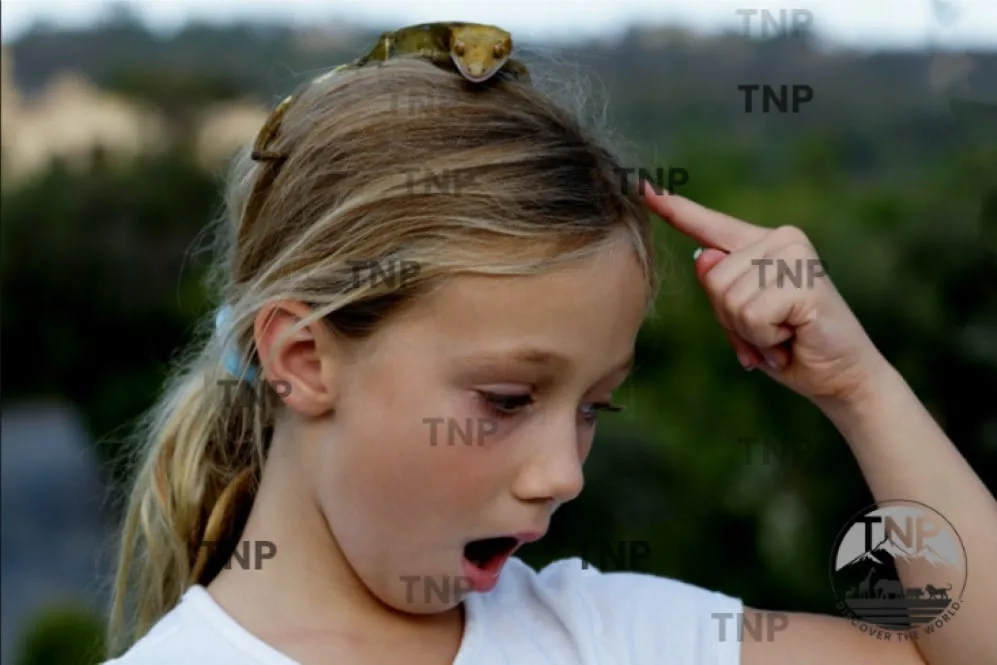
Appeal as Pets
Madagascar Day Geckos are popular for reptile enthusiasts due to their striking appearance, often highlighted by their bright blue markings and relatively low maintenance requirements. Their vibrant colors and active behavior make them fascinating pets to observe.
Care Requirements
To ensure the well-being of captive Madagascar Day Geckos, it’s essential to recreate their natural habitat as closely as possible, incorporate live plants into their enclosures, and maintain a proper temperature gradient. This includes providing a spacious enclosure with plenty of foliage for climbing and hiding, maintaining appropriate temperature and humidity levels with water droplets, and ensuring they can occasionally eat sweet fruits as part of their diet.
If you consider keeping geckos or chameleons as pets, follow this care guide.
Photographic Journey With Geckos
As a wildlife enthusiast and photographer, capturing the Madagascar Day Gecko on camera has been both a joy and a challenge. Let me share my experiences and tips for photographing these captivating lizards, whether in the wild or captivity.
Capturing the Gecko
Finding the Perfect Shot
In the wild, patience is key when photographing Madagascar Day Geckos or Phelsuma grandis, and observing them sip their gecko drink can be particularly rewarding. These agile creatures move quickly and can blend seamlessly into their surroundings. I’ve found success by observing their behavior and anticipating their movements, allowing me to capture them in their natural habitat and understand that geckos are the only lizards to vocalize.

Getting Up Close
Getting up close is essential to capturing the intricate details of these geckos’ vibrant colors and unique markings, especially since these creatures can occasionally eat sweet fruits and exhibit interesting behaviors. I’ve used telephoto or macro lenses to achieve sharp, detailed shots, allowing viewers to appreciate the geckos’ beauty up close and observe their behavior indicative of being active.
Ethical Photography Practices
Respecting the wildlife and their habitats is paramount when photographing Madagascar Day Geckos. I always maintain a safe distance to avoid causing stress or disturbance to the geckos, understanding their territorial nature. Additionally, I avoid using flash photography, as it can startle the geckos, disrupt their natural behavior, and interfere with their active day-to-day lifestyle, which includes their unique ability to hiss or other simple ways to communicate.
Chameleon Food 101: Providing The Best Chameleon Diet
Geckos Are Important
The Madagascar Day Gecko is a fascinating creature worth protecting, especially considering its potential as an exotic pet that brings attention to conservation efforts and helps maintain the balance in their natural habitats. By practicing ethical photography and supporting conservation efforts, we can help ensure the survival of these gecko species. Let’s appreciate their beauty and play our part in preserving their natural habitat.
Madagascar Bugs: Exploring the Island’s Insect Kingdom
Madagascar Day Gecko FAQs
What is a Phelsuma madagascariensis?
Phelsuma madagascariensis, the scientific name for Geckos, showcases the variety within the species, some of which are sought after as exotic pets.
What is the average size of a gecko?
The average size of a gecko varies depending on the species, but Madagascar Day Geckos typically grow to about 8 to 10 inches in length.
How Many Species of Geckos are there?
Over 2,000 species of geckos are found worldwide, and some are highly valued as exotic pets due to their unique appearances and behaviors.
Are Madagascar Day Geckos Poisonous?
No, Madagascar Day Geckos are not poisonous. They do not have claws that could deliver venom, making them safer to handle as exotic pets. They also require a water dish in their habitat to help maintain their hydration. They are harmless to humans and generally pose no threat. However, avoiding handling them excessively is essential to prevent stress, a vital consideration when keeping them as exotic pets.
What Do Madagascar Day Geckos Eat?
Madagascar Day Geckos are omnivorous, meaning they eat a varied diet of insects and fruit. This trait enhances their appeal as exotic pets and necessitates carefully balancing calcium and vitamin D3 in their diet. In captivity, they can be fed a diet of gut-loaded insects such as crickets and mealworms, as well as sweet fruits like bananas and mangoes.
What is the Lifespan of a Madagascar Day Gecko?
The average lifespan of a Madagascar Day Gecko is around 6 to 8 years in captivity when provided with proper care and a suitable environment, which must include elements like a water dish to emulate their natural habitats. In the wild, their lifespan may be shorter due to various factors such as predation and habitat loss, but day geckos mainly produce more than a hiss when threatened, a testament to their resilience.
Where Are Golden Day Geckos Native to?
Golden Day Geckos, a subspecies of the Madagascar Day Gecko, are native to eastern Madagascar. They thrive in humid environments and are often found in forested areas where they can bask in the sun and cling to smooth surfaces using their flattened toe pads, benefitting from a temperature gradient in their habitat.
Is it a valuable substrate for a gecko cage?
Using a substrate or bedding at the bottom can be helpful, and it’s important to spot clean to maintain the health of these geckos.


